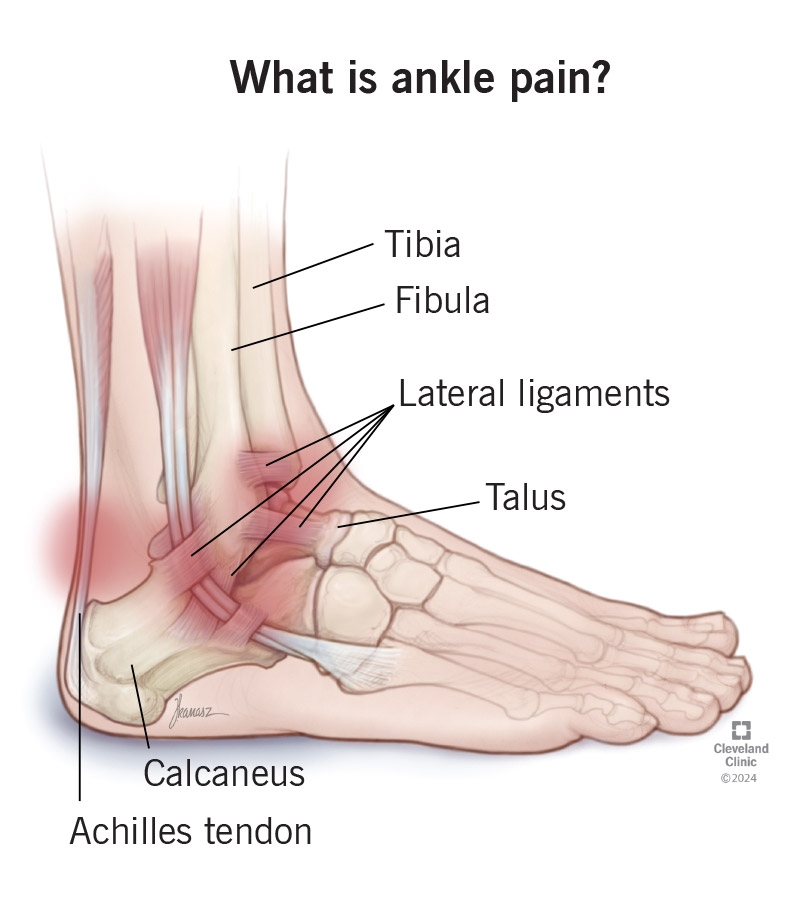Ankle pain is any pain or discomfort in your ankle. It usually gets better with at-home treatments like the RICE method and over-the-counter pain medication. Providers treat more severe pain with braces and splints, injections and surgery.
Advertisement
Cleveland Clinic is a non-profit academic medical center. Advertising on our site helps support our mission. We do not endorse non-Cleveland Clinic products or services. Policy

Ankle pain is any pain or discomfort in your ankle joint.
Advertisement
Cleveland Clinic is a non-profit academic medical center. Advertising on our site helps support our mission. We do not endorse non-Cleveland Clinic products or services. Policy
Your ankle is a complex joint made of:
Ankle pain can happen for many reasons. The most common causes include injuries, arthritis and normal wear and tear. Depending on the cause, you may feel pain or stiffness anywhere around your ankle. Your ankle may also swell, and you may not be able to put any weight on it.
Usually, ankle pain gets better with rest, ice and over-the-counter (OTC) pain medications. A healthcare provider will treat injuries and arthritis. Oftentimes, you won’t need surgery to treat these conditions.
Severe ankle injuries — especially broken bones — may require surgery. You might also need surgery if you have severe ankle pain that doesn’t get better after trying other, nonsurgical treatments.
Visit a healthcare provider if you’re experiencing ankle pain that doesn’t go away in a few days, or if the pain is getting worse.
Anke pain is extremely common and lots of injuries and health conditions can cause it.
Some of the most common injuries that cause ankle pain include:
Advertisement
Any health condition that affects your joints can hurt your ankles. Some of the most common include:
Don’t play sports or do any intense physical activity that can put more stress on your ankle until a healthcare provider says it’s safe. Follow the RICE method as soon as you notice pain or other symptoms
Visit a healthcare provider if the pain lasts more than a few days or doesn’t get better after you try at-home treatments. They’ll diagnose what’s causing it and suggest ways to help you feel better. Other common treatments for ankle pain include:
You might not always be able to prevent ankle pain, especially if it’s caused by an injury you can’t plan for. You may not be able to prevent arthritis and other health conditions, either.
Advertisement
The best way to prevent pain is to stay safe when you’re physically active. During sports or other physical activities:
Follow these general safety tips to reduce your risk of an injury:
Most cases of ankle pain are minor or temporary. Severe ankle pain needs diagnosis and treatment from a healthcare provider right away.
Visit a healthcare provider if you have ankle pain all the time, or if the pain is intense enough that you change your daily routine or avoid some of your usual activities.
Go to the emergency room or call 911 (or your local emergency services number) if you’ve experienced trauma like a car accident or severe fall. Go to the ER if you can’t move your ankle or leg, or if you think you have a broken bone.
Advertisement
Different injuries or health conditions can cause pain in different locations in or around your ankles. Peroneal tendinitis is inflammation in the tendons that run along your outer ankle bone and the side of your foot. It can cause ankle pain on the outside of your ankle.
Posterior tibial tendinitis is inflammation in one of the tendons that runs along the inside of your ankle and foot. It can cause pain on the inside of your ankle or foot.
Any other injury or condition that causes general ankle pain can also make the sides of your ankles hurt. Visit a healthcare provider no matter where you’re feeling ankle pain if the RICE method or taking NSAIDs at home doesn’t relieve the pain after a few days.
Everyone’s had a sore ankle at some point. But there’s a difference between feeling sore for a day or two and feeling like your ankles are constantly aching. Visit a healthcare provider if ankle pain is an everyday constant for you, or if you know you experienced an ankle injury.
Trust your instincts and listen to your body. People sometimes assume that ankle pain is just a part of getting older or an unavoidable side effect of their jobs or hobbies. You might feel pain every once in a while, but don’t ignore it if it’s been more than a few days in a row since you’ve been pain-free.
Advertisement
Cleveland Clinic offers treatment for ankle arthritis, bursitis, sprained ankles and other causes of ankle pain — often without surgery.

Last reviewed on 04/25/2024.
Learn more about the Health Library and our editorial process.